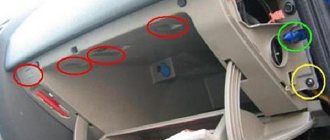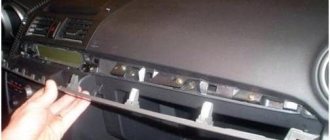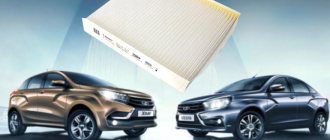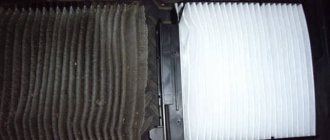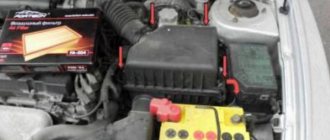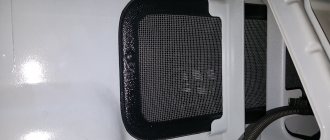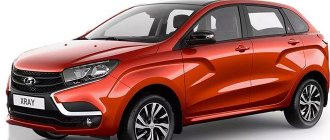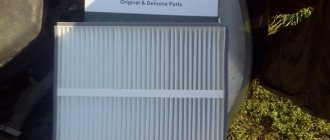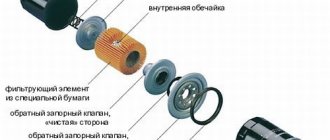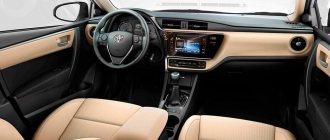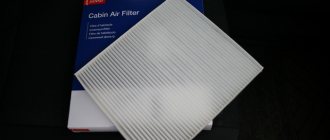Is your furnace not working well or is your air conditioner not blowing well? Regardless of the make and model of the car, anyone can encounter this problem. This is often due to a clogged cabin filter. Let's look at how to replace the cabin filter on Kia Rio cars.
The air filter is an important part of the car and its importance should not be underestimated. First of all, it is designed to prevent dust and dirt from entering certain parts and components of your car. Therefore, clogging and/or failure of the air filter can lead to possible serious troubles, and therefore unexpected costs.
General questions about replacement: article number, replacement interval, choice
The cabin filter in the Kia Rio has undergone several changes over the life of this model. If we talk about models for the Russian market, based on the version for China and therefore different from cars for Europe, the article number of the factory filter is as follows: Before restyling in 2012, cars were equipped with a primitive filter for coarse particles under catalog number 97133-0С000.
Since it does not involve replacement, but only shaking out the accumulated debris, they only replace it with a fully filtered non-original one - MANN CU1828, MAHLE LA109, VALEO 698681, TSN 9.7.117. After 2012, only a paper filter with number 97133-4L000 was installed. Its analogues are TSN 9.7.871, Filtron K1329, MANN CU21008.
When to change, what interior to install
To perform scheduled maintenance operations, there are regulations, as well as manufacturer recommendations. According to them, replacing the cabin filter of the Kia Rio IV (FB) heating and air conditioning system should be done every 15,000 kilometers or once a year.
Considering that the operating conditions of the car in most cases will be far from ideal, experts advise performing this operation approximately twice as often, in spring and autumn.
Characteristic symptoms:
- Windows often fog up;
- the appearance of unpleasant odors in the cabin when the airflow is turned on;
- deterioration of the stove and air conditioner;
They may make you doubt that the filter element is coping with its tasks and an unscheduled replacement will be required. In principle, these symptoms should be relied upon when choosing the correct replacement interval.
Suitable sizes
When choosing a filter element, owners do not always use products recommended by the car manufacturer. Everyone has their own reasons for this, some say that the original is unreasonably expensive. Some people in the region sell only analogues, so there is a need to know the sizes by which you can subsequently make a selection:
- Height: 28 mm
- Width: 200 mm
- Length: 225 mm
As a rule, sometimes analogues for the Kia Rio IV (FB) may be a few millimeters larger or smaller than the original, there is nothing wrong with that. And if the difference is measured in centimeters, then of course it’s worth looking for another option.
Selecting an original cabin filter
The manufacturer recommends using exclusively original consumables, which, in general, is not surprising. They themselves are of good quality and are widely available in car dealerships, but their price may seem overpriced to many car owners.
Regardless of the configuration, on all fourth-generation Kia Rios (including the restyled version), the manufacturer recommends installing a cabin air filter with article number 97133-D1000. You can also use the element under article number 97133-D3000; it is a complete analogue of 97133D1000 in quality and size.
It is worth noting that sometimes consumables and other spare parts may be supplied to dealerships under different part numbers. Which can sometimes confuse those who want to purchase an original product.
When choosing between a dust and carbon product, car owners are advised to use a carbon filter element. This filter is more expensive, but it cleans the air much better.
It is easy to distinguish - the paper filter accordion is impregnated with a carbon composition, and therefore has a dark gray color. The filter cleans the air flow from dust, fine dirt, germs, bacteria and enhances the protection of your lungs.
Which analogues to choose
In addition to simple cabin filters, there are also carbon filters that filter the air more effectively, but they are more expensive. The advantage of coal SF is that it does not allow foreign odors coming from the road (street) to penetrate into the car interior.
But this filter element also has a drawback - air does not pass through it well. GodWill and Corteco carbon filters are of fairly high quality and are a good replacement for the original.
However, in some retail outlets the price of the original fourth-generation Kia Rio cabin filter may be greatly inflated. In this case, it makes sense to purchase a non-original consumable item. In particular, cabin filters are considered quite popular:
Conventional dust cabin filters
- Mann Filter CU23019 – high-tech consumables from a well-known manufacturer
- BIG filter GB-98028 – popular brand, good fine cleaning
- Nevsky filter NF6548 - Russian manufacturer with an affordable price
Carbon cabin filters
- Mann Filter CUK23019/1 – high-quality and thick carbon coating
- BIG filter GB-98028/C – activated carbon
- Nevsky filter NF6548C – normal quality, affordable price
It makes sense to take a closer look at the products of other companies - they also specialize in the production of high-quality consumables for passenger cars:
- Corteco
- Filtron
- SCT
- Sakura
- GoodWill
- Fram
- JS Asakashi
- Champion
- Zekkert
- Masuma
- Nipparts
- Purflux
- Knecht Mahle
It is quite possible that sellers may recommend replacing the Rio IV (FB) cabin filter with non-original cheap substitutes with a much smaller thickness. They are not worth buying, since their filtering characteristics are unlikely to be at the proper level.
Step-by-step instructions for replacing the cabin filter
In order to replace the air filter on a Kia Rio, you must perform the following steps:
- Open the hood and find the filter box located behind the left (in the direction of travel) headlight of the car
- The box lid is held in place by two latches, which are located on the right edge. They snap off easily by hand.
- By lifting the cover up and to the side, you can remove the old filter. If the work is done in the cold, it is still better to pull the air duct pipe off the cover - both it and the plastic of the cover will noticeably harden, and bending deformation can lead to the appearance of cracks.
- Since the air flow goes through the filter from bottom to top, there is no need to worry about accumulated debris getting into the intake manifold - it will all remain in the box. It is worth removing it from there, otherwise at high speeds some of the old dirt will inevitably be drawn into the new filter by air
- The new filter is installed simply, there are no errors here. It is enough to get into the guides of the box, and you can install the cover in place. If the latches do not snap into place, you need to check whether its hooks on the left side have entered the grooves in the lower part of the box, and then press it harder - but, of course, observing the necessary accuracy.
Which filter to choose, original or analogue
From the factory, the 4th generation Rio is equipped with an original Hyundai / KIA filter 97133 D1000 . Its cost is from 650 rubles depending on the region. In addition to it, you can choose cheaper filter analogues, but of the same good quality.
- AMD AMDFC753 from 190 RUR
- AMD AMDFC753C from 500 rubles carbon
- Fortech FS150 from 170 rub.
- Goodwill AG463CF from 200 rub.
- Sakura CA28380 from 490 RUR
- TSN 97918 from 190 RUR
- Goodwill AG464CFC from 280 rubles coal
It is believed that a carbon filter filters incoming air better, but this is subject to the purchase of a high-quality filter.
Kia Rio X-Line service
The Kia Rio X Line is a sedan that has received a special off-road style, increased ground clearance and was specially adapted for Russia. Due to its increased off-road performance, the car is usually called a cross-hatchback. The car began to be produced at the Russian Hyundai plant in St. Petersburg. Compared to its predecessor, the Kia Rio, the X-Line has a higher ground clearance, slightly different dimensions (smaller length and slightly larger width) and a slightly changed appearance, mainly due to plastic body kits. The car is equipped with the same 1.4 and 1.6 liter engines, with a power of 100 and 123 horsepower. Maintenance of the Kia Rio X-line, respectively, takes place every 15,000 km or 1 year of car ownership.
List of works
TO-1 15,000 km (12 months)
At the first service of the Kia Rio X-line (which is TO-1, not to be confused with zero TO) it is necessary to replace:
- Engine oil and oil filter
- Cabin ventilation filter
And inspect the following components:
- Body paint and decorative elements
- Computer diagnostics of electronic systems
- Exterior lights and indicators
- Accumulator battery
- Drive belts
- Vacuum tubes and hoses
- Engine crankcase ventilation hoses
- Steering components
- Air conditioning system, compressor
- Engine cooling radiators, air conditioning
- Fastening components and assemblies to the body and suspension
- Front and rear suspension components
- Pipes, hoses and connections of the brake system
- Fuel lines, hoses and connections
- Wheel drive shafts, wheel bearings, CV joints
- Exhaust system
- Tires (not including spare tire)
- Disc brakes, discs and pads
- Engine Coolant
- Brake fluid
- Engine air filter
- Maintenance interval indicator, reset (if equipped)
Note: Mandatory inspection includes cleaning, adjustment and replacement if necessary.
TO-2 30,000 km (24 months)
During the second service, some additional items are added.
Replacement:
- Engine oil and oil filter
- Cabin ventilation filter
- Brake fluid
Inspection and testing:
- Body paint and decorative elements
- Computer diagnostics of electronic systems
- Exterior lights and indicators
- Accumulator battery
- Drive belts
- Vacuum tubes and hoses
- Engine crankcase ventilation hoses
- Steering components
- Air conditioning system, compressor
- Engine cooling radiators, air conditioning
- Fastening components and assemblies to the body and suspension
- Front and rear suspension components
- Pipes, hoses and connections of the brake system
- Fuel lines, hoses and connections
- Brake pedal
- Parking brake
- Fuel tank ventilation system and filler cap
- Drum brakes, drums and shoes (if equipped)
- Fuel filter
- Air filter for fuel tank ventilation system (if equipped)
- Automatic transmission fluid
- Wheel drive shafts, wheel bearings, CV joints
- Exhaust system
- Tires (not including spare tire)
- Disc brakes, discs and pads
- Engine Coolant
- Brake fluid
- Engine air filter
- Maintenance interval indicator, reset (if equipped)
TO-3 45,000 km (36 months)
Replacement:
- Engine oil and oil filter
- Engine air filter
- Cabin ventilation filter
- Battery "ERA-GLONASS" (if necessary)
Inspection, adjustment and testing:
- Body paint and decorative elements
- Computer diagnostics of electronic systems
- Exterior lights and indicators
- Accumulator battery
- Drive belts
- Vacuum tubes and hoses
- Engine crankcase ventilation hoses
- Steering components
- Air conditioning system, compressor
- Engine cooling radiators, air conditioning
- Fastening components and assemblies to the body and suspension
- Front and rear suspension components
- Pipes, hoses and connections of the brake system
- Fuel lines, hoses and connections
- Wheel drive shafts, wheel bearings, CV joints
- Exhaust system
- Tires (not including spare tire)
- Disc brakes, discs and pads
- Engine Coolant
- Brake fluid
- Maintenance interval indicator, reset (if equipped)
TO-4 60,000 km (48 months)
The fourth thing on X-line is more extensive for checks, but not for replacements
Replacement:
- Fuel filter
- Air filter for fuel tank ventilation system (if equipped)
- Brake fluid
- Engine oil and oil filter
- Cabin ventilation filter
Check and inspect the following items:
- Body paint and decorative elements
- Computer diagnostics of electronic systems
- Exterior lights and indicators
- Accumulator battery
- Drive belts
- Vacuum tubes and hoses
- Engine crankcase ventilation hoses
- Steering components
- Brake pedal
- Parking brake
- Air conditioning system, compressor
- Engine cooling radiators, air conditioning
- Fuel tank ventilation system and filler cap
- Fastening components and assemblies to the body and suspension
- Front and rear suspension components
- Pipes, hoses and connections of the brake system
- Fuel lines, hoses and connections
- Wheel drive shafts, wheel bearings, CV joints
- Exhaust system
- Tires (not including spare tire)
- Disc brakes, discs and pads
- Drum brakes, drums and shoes (if equipped)
- Engine Coolant
- Automatic transmission fluid
- Engine air filter
- Maintenance interval indicator, reset (if equipped)
TO-5 75,000 km (60 months)
Replacement:
- Engine oil and oil filter
- Cabin ventilation filter
Inspection and testing:
- Body paint and decorative elements
- Computer diagnostics of electronic systems
- Exterior lights and indicators
- Accumulator battery
- Drive belts
- Vacuum tubes and hoses
- Engine crankcase ventilation hoses
- Steering components
- Air conditioning system, compressor
- Engine cooling radiators, air conditioning
- Fastening components and assemblies to the body and suspension
- Front and rear suspension components
- Pipes, hoses and connections of the brake system
- Fuel lines, hoses and connections
- Wheel drive shafts, wheel bearings, CV joints
- Exhaust system
- Tires (not including spare tire)
- Disc brakes, discs and pads
- Engine Coolant
- Brake fluid
- Engine air filter
- Maintenance interval indicator, reset (if equipped)
TO-6 90,000 km (72 months)
Replacement:
- Brake fluid
- Automatic transmission fluid
- Engine oil and oil filter
- Engine air filter
- Cabin ventilation filter
- Battery "ERA-GLONASS" (if necessary)
Inspection and testing:
- Body paint and decorative elements
- Computer diagnostics of electronic systems
- Exterior lights and indicators
- Accumulator battery
- Drive belts
- Vacuum tubes and hoses
- Engine crankcase ventilation hoses
- Steering components
- Brake pedal
- Parking brake
- Air conditioning system, compressor
- Engine cooling radiators, air conditioning
- Fuel tank ventilation system and filler cap
- Fastening components and assemblies to the body and suspension
- Front and rear suspension components
- Pipes, hoses and connections of the brake system
- Fuel lines, hoses and connections
- Wheel drive shafts, wheel bearings, CV joints
- Exhaust system
- Tires (not including spare tire)
- Disc brakes, discs and pads
- Drum brakes, drums and shoes (if equipped)
- Fuel filter
- Air filter for fuel tank ventilation system (if equipped)
- Engine Coolant
- Maintenance interval indicator, reset (if equipped)
TO-7 105,000 km (84 months)
- Engine oil and oil filter
- Cabin ventilation filter
Examination:
- Body paint and decorative elements
- Computer diagnostics of electronic systems
- Exterior lights and indicators
- Accumulator battery
- Drive belts
- Vacuum tubes and hoses
- Engine crankcase ventilation hoses
- Steering components
- Air conditioning system, compressor
- Engine cooling radiators, air conditioning
- Fastening components and assemblies to the body and suspension
- Front and rear suspension components
- Pipes, hoses and connections of the brake system
- Fuel lines, hoses and connections
- Wheel drive shafts, wheel bearings, CV joints
- Exhaust system
- Tires (not including spare tire)
- Disc brakes, discs and pads
- Engine Coolant
- Brake fluid
- Engine air filter
- Maintenance interval indicator, reset (if equipped)
KIA Rio
Салонный С„Рельтр предназначен для очистки РІРѕР·РґСѓС…Р°, R єРѕС‚орый РїРѕСЃС‚СѓРїР°РµС ‚ через воздухозаборные отверстия СЃ улицы РІ салон. Задача крайне актуальная, если РІС‹ проживаете РІ РєСЂСѓРїРЅР ѕРј РіРѕСЂРѕРґРµ.
RљРѕРЅС†РµРЅС‚рация выхлопных газов РЅР° РґРѕСЂРѕРіРµ RІС‹СЃРѕРєР°СЏ, Рї SЂРё этом даже СЃ Р·Р°РєСЂС‹С ‚ыми окнамв РІ машРеРЅСѓ RїРѕРїР°РґР°РµС‚ РѕРіСЂРѕРјРЅРѕРµ RєРѕР»РёС‡РµСЃС‚РІРѕ RІСЂРµРґРЅС‹С… веществ.
R'РѕР·РґСѓС… СЃ РґРѕСЂРѕРіРіРё содержит RјР°СЃСЃСѓ RѕРїР°СЃРЅС‹С… для R·РґРѕСЂРѕРІСЊСЏ веществ:
- пыль РѕС‚ С€РеРЅ;
- мелкРеРµ частицы резРеРЅС‹;
- асбест от тормозных колодок;
- бактерии, РІРІроСЂСѓСЃС‹ Рё СЃРїРѕСЂС‹ растений.
Еслговорить конкретно Рѕ выхлопном газе РѕС‚ машины, S‚Рѕ РѕРЅ включает РІ себя R ±РѕР»СЊС€Рµ 200 различных ядоввитых веществ.
RS‚Рѕ РѕРєСЃРёРґС‹ углерода, серы Рё азота, соединения С‚СЏР¶РµР»С ‹С… металлов, сажа, S‚тороводород РјРхРѕРіРѕРµ РґСЂСѓРіРѕРµ.
R»Р°Р¶Рµ для полностью Р·РґРѕСЂРѕРІРѕРіРѕ S‡РµР»РѕРІРµРєР° высокая РєРѕРЅ S†РµРЅС‚рация выхлопных РіР° Р·РѕРІ опасна, Р° что говорить, если Сѓ вас астма или РґСЂСѓРіРёРµ Р·Р °Р±РѕР»РµРІР°РЅРёСЏ РґС‹С …ательной системы?
R'SЃРµ SЌS‚Рё вещества SЃРїРѕСЃРѕР±РЅС‹ RїSЂРІРІРѕРґРёС‚СЊ Rє RєСЂР°Р№РЅРµ RЅРµРїСЂР ёСЏС‚ным последствниям: RєРёСЃР»РѕСЂРѕРґРЅРѕРµ RіРѕР»РѕРґР°РЅРеРµ, РїСЂРё РєРѕС ‚РѕСЂРѕРј РІРѕР ·РЅРєРєР°РµС‚ головная боль, одышки иаже SЃРЅРёР¶Р°РµС‚СЃСЏ SЃРєРѕСЂРѕS ЃС‚СЊ реакции.
РћРєСЃРёРґС‹ азота РїСЂРёРІРѕРґСЏС‚ Рє поражению дыхательных РїСѓS ‚ей Рё легкиС..., Р° бензол .
